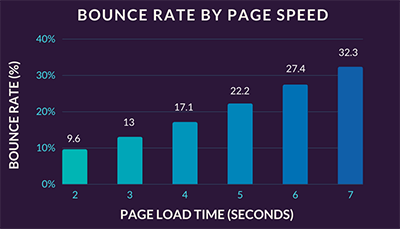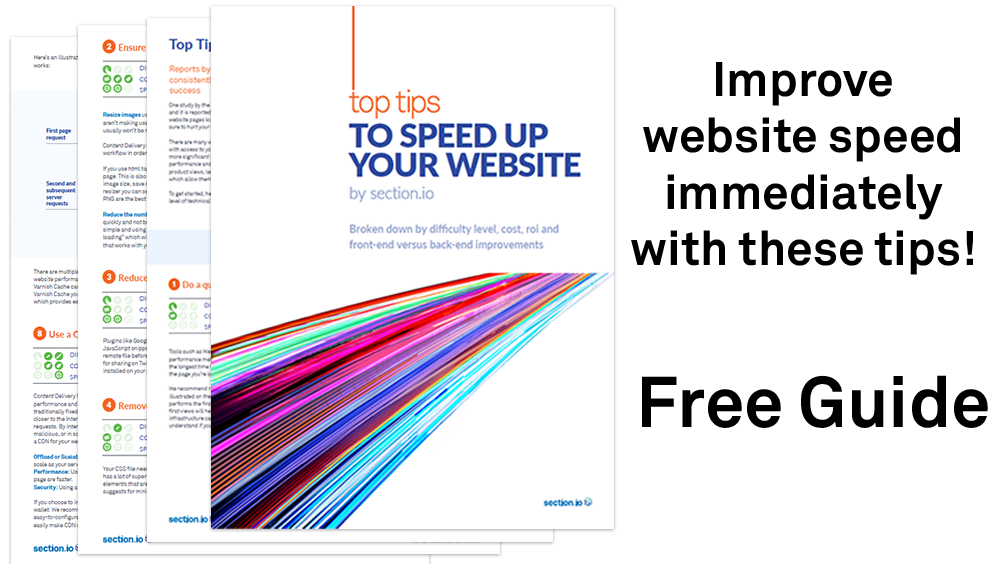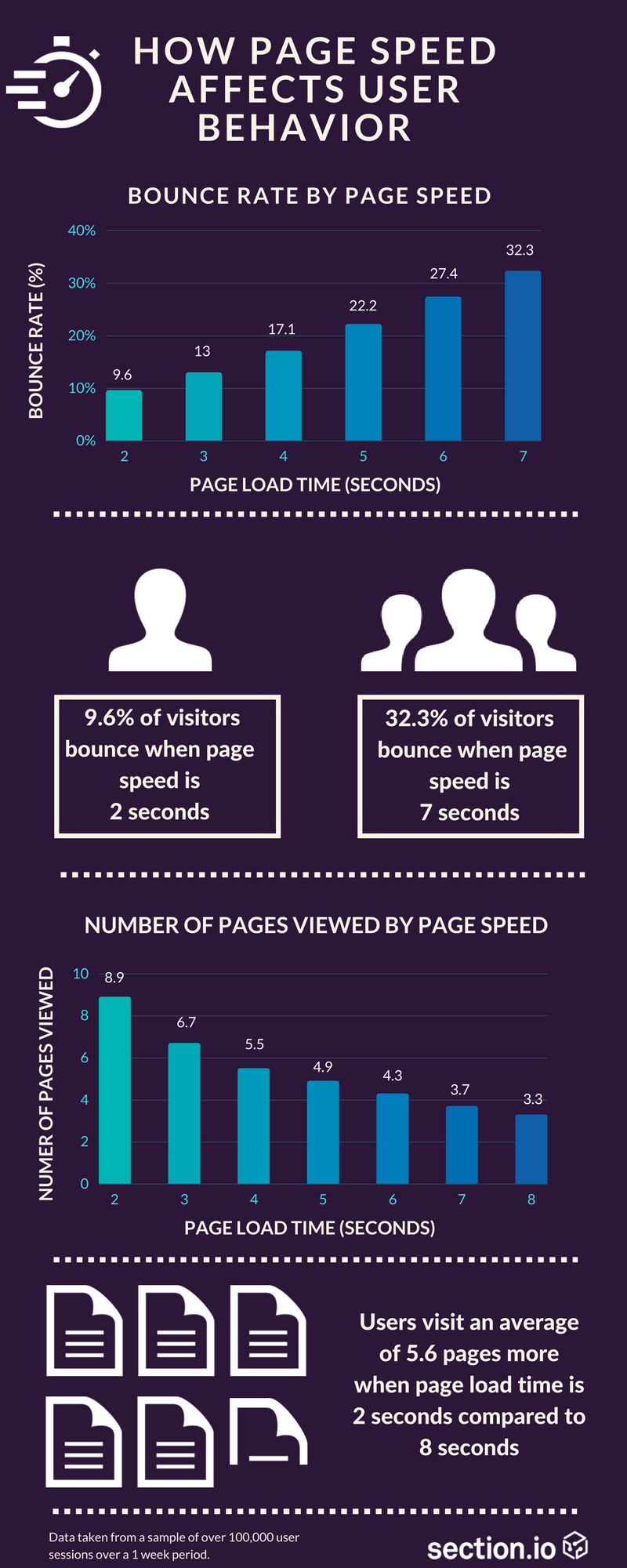 It’s become common knowledge that the speed at which pages load is a crucial part of user experience, and recently page speed has become more and more important in other areas - Google’s search engine ranks pages based on page load time (specifically, time to first byte), and Facebook has announced that it will prioritize links that load quickly in its newsfeed over those that are slow to load, saying “We’ve heard from people that it’s frustrating to click on a link that leads to a slow-loading webpage. In fact, even more broadly on the internet, we’ve found that when people have to wait for a site to load for too long, they abandon what they were clicking on all together.”
It’s become common knowledge that the speed at which pages load is a crucial part of user experience, and recently page speed has become more and more important in other areas - Google’s search engine ranks pages based on page load time (specifically, time to first byte), and Facebook has announced that it will prioritize links that load quickly in its newsfeed over those that are slow to load, saying “We’ve heard from people that it’s frustrating to click on a link that leads to a slow-loading webpage. In fact, even more broadly on the internet, we’ve found that when people have to wait for a site to load for too long, they abandon what they were clicking on all together.”
By doing this, Facebook is acknowledging that their users expect a fast-loading link, even if it is directing users to content outside of Facebook.
How Page Speed Impacts Visitor Behavior
Large websites including Amazon have conducted studies showing that users expect a page to load quickly, and in fact that slower page load times can lead to a significant drop in revenue - some estimates say up to 1% loss for every 100ms delay in page load time. Section’s own studies have also shown this, with leading ecommerce beauty site Adore Beauty finding that faster pages resulted in a 16.5% increase in conversion rate and a consistent improvement in revenue.
But translating these studies from high-volume websites like Google and Amazon to the many thousands of small and mid-size websites out there can be difficult. Some may argue that page speed matters more for giant websites who are expected to perform well even under high traffic, while other studies have found it hard to measure the impact of page load time across thousands of websites.
It can be difficult for websites to measure the impact of page speed on user experience themselves. Google Analytics takes a very basic measure of website speed as experienced by your visitors - they show overall page load time for a sample of 1% of visitors. For many websites the Google Analytics sample size would be extremely small and therefore skewed by the different connections of the end-users being sampled. More advanced tools like New Relic measure the various elements of page load time - including back end time, front end time, and total page load time - but do not link this data to marketing metrics like page views per session and bounce rate.
Additionally, many of the often-cited page speed metrics are from several years ago, when end-users had different connection speeds (especially on mobile devices) and expectations around how fast pages should load. Now many users expect even faster page load times, and with the growth of ecommerce-only retail businesses and internet-only media companies, page speed has more of an impact than ever.
So, If you are a medium-size ecommerce site with good brand awareness and a loyal customer base, does page speed really impact your bottom line, and how do you measure it?
We are happy to announce that Section’s Real User Monitoring now includes business metrics that show how page speed impacts the number of pages viewed by a user and the average bounce rate. We’ve also conducted a study on a sample of websites (primarily ecommerce websites) already using Section’s RUM. The results clearly demonstrate that slower page speeds negatively affect both the number of pages viewed by a single visitor and the average bounce rate (the percentage of visitors who leave after only visiting one page).
Page Speed and Bounce Rate
The infographic below divides average total page load times experienced by real visitors into brackets of 1-second, 2-seconds, 3-seconds, etc. If a visitor went to multiple pages on a website, the page load time is averaged - so if the first page loaded in 4 seconds, and the second loaded in 2 seconds, they would be put into the “3 seconds” bracket to represent the average time a page took to load.
As you can see, the bounce rate increases as page speed goes up, meaning that more people are only visiting one page the slower the first page they visit is. For users with an average page load time of 2 seconds, the bounce rate is quite low - only 9.61%. This goes up slightly for those with an average page load of 3 seconds, to 13.0%. There is a jump in bounce rate of 4.1% from 3 to 4 seconds, with 4 second page load time having a bounce rate of 17.1%, and a 5.1% jump from 4 seconds to 5 seconds. For those users experiencing an average page load time of 7 seconds, the bounce rate is 32.3%.
Page Speed and Number of Pages Viewed
So now we know that slower page load times mean less visitors going to more than one page, but how does page speed impact the total number of pages users visit? As you might expect given the impact page speed has on bounce rate, the faster pages load on average the more pages visitors go to.
As shown in the above graph, those with an average page load time of 2 seconds view 8.9 pages on average, while those with an average page load time of 7 seconds view only 3.7 pages on average. The number of pages viewed consistently decreases as page speed decreases, and the difference in pages viewed between users averaging 2 second load times and users averaging 4 seconds is 3.x pages. This means that a 2 second delay in page load time could mean a user exits your site 3 pages earlier.
How Page Speed Impacts Revenue
What does all of this mean for your website? From these studies we can see that page speed does impact both number of pages viewed per session and the bounce rate. As any marketer knows, these are important metrics that can have a direct impact on conversion rate and revenue.
Pages viewed are important because they show a visitor is engaged with your website and is staying on the site through several page loads. For ecommerce sites, more pages viewed often means a higher likelihood that a visitor will add one of the items on a page to their cart. It also could mean larger cart sizes. As we have found previously in A/B tests with a leading online beauty store, faster pages equal larger carts and more revenue.
Pages viewed per session are also a crucial metric for media sites and other websites which rely on page views for advertising revenue. The cost and effort of acquiring a new visitor to your website is often high, so once they are on your site you want to make sure they will stay and view several pages to get a strong return on investment. The faster the pages load, the more likely they will view more pages and become a valuable visitor in terms of both advertising and likelihood to return to your website.
Bounce rate is the percentage of visitors who come to your site and leave after only viewing one page. This metric can be impacted by many factors, including page content, page design, and how relevant your page content is to the search term or advertisement that brought visitors to your website. Page speed also impacts bounce rate, and because those who bounce only visit one page on your website, the load time of that first page is extremely important. If a visitor has never come to your website before, they will need to collect all assets from your web server or cache server. A very slow time to first byte or start render time could mean visitors leave your website before the first page has even loaded.
The data in this post demonstrates that page speed does have a clear effect on both bounce rate and number of pages viewed, but it’s important to remember that every website is different, and content, design, and overall user experience will also impact these metrics. To measure the effect page speed has on your specific website and visitors, you can install Section’s Real User Monitoring and start collecting this data right away. Section’s RUM is included with all Section accounts, contact us to get started with a free 14 day trial.

